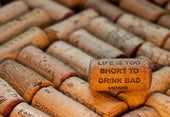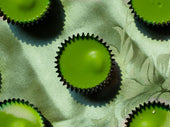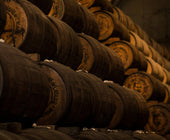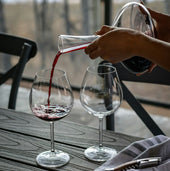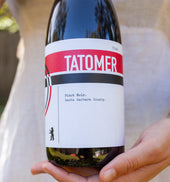
The Life of a Cellar Rat

Cellar workers, or cellar rats, are often romantically portrayed in movie fiction wearing pristine Carhartts and working in immaculate barrel rooms. The reality couldn’t be more different.
Most work in the cellar involves liquid and plenty of it. Grape juice, grape must, wine, cleaning solutions, sterilizing solutions, and mass quantities of clean water are the cellar rat’s constant companion. This leads to soggy boots, damp pants and a Jackson Pollock-like display of stains on all clothing. It also involves noise—from a rattling bottle line whizzing by your ear to the endless BEEP-BEEP-BEEP of a forklift in reverse. Most of all, it requires manual labor. Lifting up, punching down, shoveling out, bending down, climbing up—a day in the cellar rat’s life is a HIIT workout—no gym membership required. In this wet, noisome, strenuous environment, the science and art of winemaking is achieved. And, it is all dependent on the muscular efforts of the resident cellar rat.
From the instant the grapes are crushed to the moment their elixir is placed in a bottle, the cellar rat is engaged in nearly constant, frenetic physical activity. They are the first to arrive and often the last to depart, leaving a clean winery with sparkling floors and neatly coiled hoses in their wake.
Like the twelve labors of Hercules, the cellar rat performs all the specific tasks associated with each stage of winemaking from fermentation to bottling. And, nearly all of them require cleaning containers and hoses, sanitizing them and leaving them ready for their next use. Winery tasks like pressing, crushing and bottling are particularly labor intensive since the equipment involved is large, has many moving parts and must be dis-assembled to be cleaned properly.
Cellar rat duties extend far beyond this endless cycle of wash-rinse-sanitize-repeat. A frequent duty is moving wine—in containers or with hoses. Things can get messy quickly whenever the wine is in a hose and not in a bin or barrel. Valves can fail, hoses can come loose. In the case of one young winery worker, a wrong valve was turned loosing a jet of wine and grapes across the room at the rate of a half-barrel per minute. Our hero body-blocked the valve. A new tee shirt is a lot cheaper than a barrel of premium Cabernet Sauvignon.
Moving wine also requires intrepid forklift skills. A full wine barrel weighs 600lbs and contains 300 bottles worth of wine. That’s a lot of value to move gently. One wrong move with a forklift and a barrel can be punctured or dropped. Yet, workers do it daily from alarming heights in very cramped quarters—especially into and out of the barrel room.
The barrel room is an exciting workplace where every day includes “bung patrol”. These rubber barrel stoppers occasionally yield to the pressure of fermentation and gleefully fly from the bung hole with an audible popping sound. Bung Patrol requires going into the canopy of the cathedral-like space to sleuth out the origin of the bung. Free-rock-climbing skills are a must. But, it is absolutely necessary to prevent the oxidation and evaporation of wine.
Even well-stoppered barrels lose wine to evaporation. This lends a wonderful fragrance to the barrel room, but also requires “topping” off the wine—another cellar rat task. While the bung’s out, the cellar rat will take the opportunity to inspect the wine. They serve as extra “eyes” and “noses” for the winemaker. They may inoculate the wine with yeast or take a lab sample. If they notice an “off” odor, the barrel may have to be racked by gently removing all the wine, hosing out the lees, cleaning the barrel and replacing the wine. Racking is messy, strenuous, dicey, and above all, wet.
A cellar rat’s life requires a lot of hard work, cat-like reflexes and an endless supply of hand-chapping labor. Why do they do it? It can be an entry point to becoming a winemaker. There’s also a lot of variety. On any given day, the wines are at every stage of fermentation and maturation. The unexpected happens for the good and the bad, and every bottling is an opportunity to watch the fruits of their sometimes years-long labor go out to the public. Perhaps there is a more compelling reason: exhilaration. One cellar rat described it this way, “I love the tank of grapes and the extraordinary smells of yeasty-breadiness, combined with all the fresh fruit and flower smells of young fermentations. Watching wine come alive is exciting!”
 Patty Lyn Tweten is a writer, graphic designer and vineyard owner. She is also a devoted fan of rosés having helped her husband make their own with the sagniée method. Instagram Linkedin
Patty Lyn Tweten is a writer, graphic designer and vineyard owner. She is also a devoted fan of rosés having helped her husband make their own with the sagniée method. Instagram Linkedin






